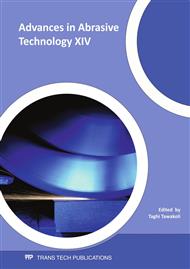p.257
p.264
p.270
p.276
p.282
p.287
p.294
p.300
p.309
A Quick-Test Method to Determine the Grinding Wheel Topography Based on Acoustic Emission
Abstract:
A quick-test method for the determination of the topographic characteristics of a CBN grinding wheel is developed based on acoustic emission technology. For implementing the strategy, an acoustic emission (AE) monitoring system was integrated into a 3 axis CNC grinding machine. A computer with specific software allows the signal acquisition and visualization of the AERMS signals, which are originated through interferences between the grinding wheel and dressing tool in a range of a few micrometers. The acquired AERMS signals from these interferences are used in order to establish an on-line map from the grinding wheel periphery, indicating the active cutting grains during the contact amid grinding wheel and dressing tool. The implementation of such activity supported by AE has led to satisfactory results regarding the required time to evaluate the strategy as well as the verified correlation with different grinding topographies caused by changes in the dressing parameters.
Info:
Periodical:
Pages:
282-286
Citation:
Online since:
August 2011
Authors:
Keywords:
Price:
Сopyright:
© 2011 Trans Tech Publications Ltd. All Rights Reserved
Share:
Citation:


